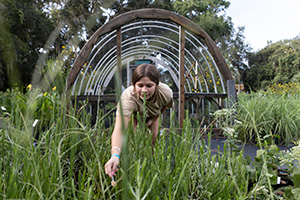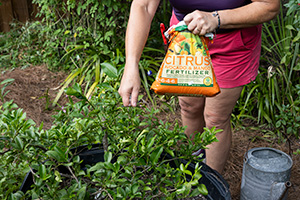Vegetable Gardening: Applying Fertilizer
Fertilizer is a powerful tool that can help plants thrive if used appropriately. If applied incorrectly, it can not only harm plants, but also the environment.

When to Fertilize
Regular fertilizer applications keep plants vigorous and productive. When plants grow reluctantly or start turning yellow, fertilizer may help. If plants are vigorous and green, you can wait a little bit before applying more fertilizer. Too much fertilizer can burn plants. Tomatoes and beans given too much fertilizer grow lots of foliage but little fruit.
Vegetables growing in porous, well-drained soil should be fed frequently. Usually a balanced fertilizer is applied every three to four weeks throughout the growing season. Don’t stop applications when fruit appears—continue to apply fertilizer as needed to ensure continued production.
Vegetables growing in clay soils will need less fertilizer than those in sandy soils. One application every four to six weeks after planting is typically enough. Crops growing in organic soils may need little additional fertilizer—again, just use foliage color and plant vigor as guides. In gardens where the soil is sand enriched with organic matter, one or two additional applications at intervals or three to four weeks is usually enough.
We usually suggest that you select something with 2% phosphorus or less in accordance with Florida State Law, but edibles are the exception. But you may not need extra phosphorus in your vegetable garden; a soil test can help you determine which nutrients you truly need.
Types of Fertilizer
There are many options for how you convey nutrients to your plants. Many gardeners use a combination of different fertilizers and techniques. Try using granular products or manures to supply the main nutrients and liquids to correct minor deficiencies or quickly boost growth.
Dry Fertilizer
Dry fertilizer can be applied in many ways. Scatter it over the entire garden, down a row, or ring individual plants. You can broadcast dry fertilizer (1 pound for each 100 square feet of garden or 100 feet of row) over the entire garden plot before planting. Then after planting, side-dress along the plant rows. The fertilizer should be applied 2–3 inches to the side of, and 1–2 inches below, the seed level or plant row. Avoid applying fertilizer when foliage is wet, and water after applying it to remove particles from foliage. For best results, use small amounts or light concentrations of fertilizer, and spread it over the root zone.
Animal Manures
Composted animal manures used in place of inorganic fertilizer are best applied as a side dressing—this means they’re placed next to rows.
Water-soluble Fertilizer

Water-soluble fertilizers are often useful as a quick boost for vegetables. Liquids or crystals mixed with water are applied as frequently as once a week. The nutrients, easily distributed by a gardener with a sprinkling can, are readily available to plants. These fertilizers are especially handy for container-grown plants.
Foliar feeding, a technique of spraying plants with dilute liquid fertilizer, is rarely part of regular maintenance. Instead, use it to provide a special boost or to supplement micronutrients like iron, manganese, or zinc.
Preventing Pollution
To prevent water pollution from nutrient leaching and runoff, always follow these steps when fertilizing your vegetable garden.
- Follow UF/IFAS recommendations. Ideal rates, application timings, and formulas are different for different plants.
- Keep fertilizer off hard surfaces. If fertilizer gets spilled on a hard surface (like a driveway), sweep it up and dispose of it. Fertilizers can wash into storm drains and from there into a nearby water body.
- Don’t fertilize before a heavy rain. If rain is forecast in the next twenty-four hours, hold off on applying fertilizer. Rain can wash fertilizer off landscapes or cause it to leach into groundwater, contributing to pollution.
- Know your water source. If you use reclaimed/recycled water for irrigation, keep in mind that it can contain nutrients, including nitrogen, and adjust the amount you fertilize accordingly.
